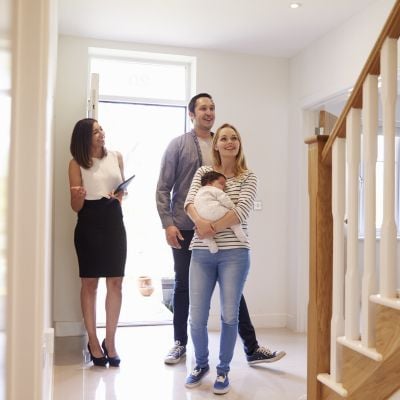Benefits of a purchase plus improvements mortgage
Not every home is a turn key, move in ready, showroom quality property. Some require work and, in some cases, that work can be costly.
If you aren’t independently wealthy – and don’t want to take on loads of additional debt with something like a line of credit – a purchase plus improvements mortgage is a great option. With this type of mortgage, you can combine the costs of the home with the costs of the improvements into one, easy to manage mortgage loan.
Other benefits include being able to customize the home to your own style and preferences, a luxury not offered to buyers of move-in ready homes. And, with the extra work you put into the home, you’re likely to increase the value of the home. In that sense, a purchase plus improvements mortgage can be viewed as an investment of sorts.
Purchase plus improvements mortgages allow you to spread the cost of renovations over the life of the mortgage, making it more manageable, financially. Also, by financing the improvements through the mortgage, you’ll likely benefit from lower interest rates compared to other forms of financing such as personal loans or credit cards.
How much home can you afford?
Whether you're hunting for a new home or looking to refinance your mortgage, knowing how much your new loan might cost you is critical. Use our handy mortgage calculator to help you understand what your payments could look like.
Get StartedHow does a purchase plus improvements mortgage work?
So, you’ve found a home that needs a little work. It’s going to be costly, but the price of the home is a steal and you know the work you put into it will only increase the value of the home. You’ve heard about purchase plus improvements mortgages – obviously, since you’re reading this – but you aren’t sure how they work.
Here’s what you can expect, after you’ve found your property.
Estimate improvement costs
Get quotes or estimates for the renovation work you expect to have done. These can include upgrades such as kitchen, bathroom, bedroom, or any other type of renovation, roof repairs, plumbing or electrical work, or energy efficiency improvements. This will help you determine how much you’ll need for improvement costs.
Get approved for a mortgage
Apply for a mortgage that includes both the purchase price of the property and the estimated cost of the renovations. The lender will evaluate your application based on the combined value of the property, the proposed improvements and your overall financial situation. Similar to a standard mortgage, they’ll look at your debt, income and credit history.
There are maximum amounts that lenders will provide for the improvement part of the mortgage. These are typically the lesser of $40,000 or 20% of the “initial” property value for uninsured mortgages (mortgages without CMHC insurance) and a maximum of 10% of the “as improved” value of the property, for mortgages with CMHC insurance. However, these are general guidelines. Ask your lender for their specific rules.
Get access to the funds
Once the mortgage is approved and the home purchase is completed, the lender will typically give the funds for the purchase price of the property to the seller. The remaining funds allocated for the improvements are held in escrow or released in stages as the renovations progress.
Complete renovations
You’ll be given a timeline for finishing the renovations. These timelines are usually between 90 and 180 days, but every lender is different. Make sure you understand how much time you’ve got to complete the improvements and work with your contractor to meet that deadline. Depending on the lender's policies, there may be requirements for inspections or documentation to verify that the renovations are completed as planned.
Finalize the mortgage
Once the renovations are finished and any required inspections or documentation are provided, the lender finalizes the mortgage, and the property becomes fully financed.
Purchase plus improvements mortgage factors to consider
Before diving headfirst into purchasing a home with a purchase plus improvements mortgage, consider a few things to make sure it’s right for you.
Consider the market value of the property. Since it will require additional costs, you’ll want to understand whether or not the purchase price is a good deal or not. You don’t want to pay market price for a home that requires a bunch of extra work, time and money.
Get more than one quote for the work you expect to have done. Understand how much you can expect to shell out in improvements; the overall cost to purchase the home and improve it is just as important as the buying price.
Shop around for the best mortgage. Most lenders offer a purchase plus improvements option, so call around to see who offers the best rate and terms. A mortgage broker can help you with this process – they’re free to use since they’re compensated by the lender.
Finally, get a pre-approval to understand how much you can afford.
Unexpected vet bills don’t have to break the bank
Life with pets is unpredictable, but there are ways to prepare for the unexpected.
Fetch Insurance offers coverage for treatment of accidents, illnesses, prescriptions drugs, emergency care and more.
Plus, their optional wellness plan covers things like routine vet trips, grooming and training costs, if you want to give your pet the all-star treatment while you protect your bank account.
Get A QuotePPI mortgage risks and considerations
Purchase plus improvements mortgages have a lot of benefits. There are, however, risks. But, anything home buying or money-related comes with risks. Like with any investment, carefully consider both the positives and negatives before signing on the dotted line.
Some potential risks of a purchase plus improvements mortgage include:
Overestimating the final value
If the estimated cost of renovations is too high or if the improvements don’t increase the value of the property like you had hoped, you may end up owing more on the mortgage than the property is worth. This is called being “underwater” on your mortgage and this negative equity situation can cause issues if you have to sell the property in the near future.
Incomplete or disappointing renovations
There is a risk that the renovations may not be completed as planned or that they don’t live up to your expectations. This could result in additional costs to fix issues or may negatively impact your feelings toward the home.
Cash flow issues
Financing both the purchase and renovations through a single mortgage can strain your cash flow, especially if unexpected expenses arise during the renovation process. It's important to budget carefully and ensure you have enough funds to cover any unforeseen costs. This is where a solid emergency fund would come in handy.
Lender requirements
Lenders may have specific requirements and restrictions for the types of renovations that can be financed through a purchase plus improvements mortgage. Make sure to carefully review the lender's guidelines to ensure their renovation plans meet the necessary criteria.
Market fluctuations
Economic factors and changes in the real estate market can affect the value of the property and the feasibility of recouping the costs of renovations. Consider the potential impact of market fluctuations on your investment and long-term financial goals, considering both positive and negative market impacts.
How to qualify for a PPI mortgage
Luckily, the process for qualifying for a purchase plus improvements mortgage is similar to applying for a traditional one. The lender will evaluate you based on:
- Your credit score
- Income and employment
- Your down payment, which will likely range from 5%-20%
- Your renovation plans and estimated cost of completing them
- An appraisal of the property
Comparison with other financing options
A purchase plus improvements mortgage is just one option for financing, if the home you plan to buy requires work before you move in. Others include a personal loan or a line of credit.
Both of these options offer more flexibility than a purchase plus improvements mortgage; they’re separate loans that can be paid off separately, instead of rolling the costs of the reno into your mortgage. However, they may come with higher interest rates. You might also have issues with financing a home that requires work, so that’s something to consider.
Your best plan is to get quotes for all three types of financing options to see which one makes the most sense financially, and for your individual situation.
The bottom line
A purchase plus improvements mortgage offers the convenience of financing both a home purchase and renovation costs in a single loan, simplifying the borrowing process. It provides an opportunity to customize and improve the property to meet your needs without requiring upfront cash for renovations. Additionally, it can increase the value of the home and potentially result in higher equity.
However, there are risks involved, such as overestimating renovation costs, leading to negative equity if the improvements don't add sufficient value. There's a possibility of issues with renovations, requiring additional expenses and your lender may have restrictions on eligible renovations.
It’s important to weigh the pros and cons – and consider whether alternative financing plans make more sense – before choosing this type of mortgage.
Purchase plus improvements mortgage FAQs
Can the purchase plus improvement amount be used towards your down payment?
No, the improvements part of a purchase plus improvements mortgage must be used toward the improvement of the home. These renovations require an estimate that you’ll have to share with the lender before you qualify.
Can the purchase plus improvement amount reduce your down payment?
No, you’re still required to meet minimum down payment requirements for buying a home in Canada, which is 5%.
What documentation do I need for a PPI mortgage?
You’ll need to provide proof of income, your credit report, your debt and investment information and renovation quotes.
What types of improvements are eligible?
Every lender is different in terms of the improvements that are eligible, but typically, these include: structural improvements, kitchen and bathroom remodeling, roofing and flooring, cosmetic upgrades and safety upgrades.
Can I do the work myself?
Yes, you can do the work yourself. However, in doing so, only the cost of materials is covered with a purchase plus improvements mortgage. You can’t pay yourself a salary to do the work.
What happens if the cost of improvements goes over the estimated amount?
If you exceed the amount borrowed to you by your lender, you’ll need to arrange alternative financing, such as a separate loan or paying cash for the extra expenses.
Sponsored
You're 5 minutes away from the best mortgage
Searching for your perfect mortgage shouldn’t be hard. Homewise is an online brokerage that will negotiate on your behalf with more than 30 big banks and other lenders, completely free, and it only takes five minutes to apply.
If you're in the market for a new mortgage, or if you're looking to refinance before interest rates rise again, go to Homewise now and answer a few simple questions to get started.









